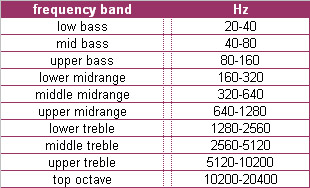Actually, it is.Well no, that's not "all they're saying."
Unfortunately, you do not appear to be among them.But anyway, at least other people understand the point.
Last edited:
Actually, it is.Well no, that's not "all they're saying."
Unfortunately, you do not appear to be among them.But anyway, at least other people understand the point.
Perhaps you don't know what I've investigated, and haven't investigated some of the things I have.
It was caused most likely by expectation bias. And a 1.5dB response deviation up in the upper treble isn't significant.
Upper treble is considered 6khz-20khz.

 )
) 
That one works too! That divides it into two octave chunks and extends the range beyond the range of human hearing to make up the extra octave. Not much above 10kHz!
Yes, cherry picking sources does seem to work. Meanwhile, other sources have the organ going above 16khz (and entire range well exceeding piano). And CD music is recorded down to 20hz, while pipe organ can go below that.
https://www.hifisentralen.no/forume...ass-og-musikk-080830-frequency-ranges.xls.pdf

|
Stay updated on HiBy at their facebook, website or email (icons below).
Stay updated on HiBy at their sponsor profile on Head-Fi.
|
@Phronesis . we've been through this, but if it's not testable, what use is it to us? are we theoretical audiophiles now? you're stuck on subconscious being important in the listening process, and no doubt it is in general. but in this specific context, is it?
here are the conditions required to make 2 devices affect us differently at subconscious level but not at a conscious one:
1/ the variation between the gears must be too small to trigger a conscious reaction or be outside the range of hearing.
2/ the variation must be big enough to be properly and consistently perceived by the ear despite various external and internal noises. and the subconscious reaction must be triggered by hearing, not body shaking, vision, smell, preconception... otherwise it's not about hearing anymore.
3/ the subconscious reaction mustn't cause any change at a conscious level(else it would fall under what's audible in a listening test).
4/ it still has to matter for the brain. as the general consensus seems to be that we constantly discard a great deal of sensory data without really processing it much, if only for the sake of being able to function and have coherent thoughts.
how often would you expect those conditions to be met? given how those conditions have somewhat contradictory requirements, your only hope would be a range in the area strictly below the known hearing thresholds. so even with this rather rational but optimistic idea, what could have a subconscious impact while not generating a conscious one, is likely to be highly specific. at least in amplitude, but most likely in all aspects. making it something, even in this open minded hypothesis, that would require hyper specific variations to occur between 2 devices. making the all thing a pretty rare occurrence, if it can happen at all. so that's far from your quasi systematic need to bring it up as a variable we can't dismiss when audibility is questioned.
again, we don't know much about the brain, and the general concept of subconscious seems to agree with a lot of human behaviors. I'm not trying to reject that model. I'm just saying that it's unlikely to have a place in the hearing part of feeling differences between gears. now if we count the all experience sighted, then I'd be tempted to put subconscious stuff at the top of the list along with preconceptions. but it's a very different matter.
"Going above" does not mean that that part is responsible for any appreciable portion of its perceived signature sound. (certainly not if I'm categorically deaf to the whole octave at 38 years old)
And there's no LOWER limit to what any PCM format can record. It will happily record and play back 0.0000001Hz if you have the recording and playback equipment for it. (movable concerete blocks maybe?)
I think that then begs the question if audio reproduction should strive for recording aspects of the original recording venue or be within what’s considered average human hearing. I’ve seen similar debates about human perception vs digital reproduction in photography. White balance, for example is separate then human perception (which has rods and cones for different acuity at different wavelengths for daylight vs night).
I'm thinking not so much about thresholds of perception, but rather the effects of time and memory on the operation and interactions of conscious and subconscious perception (and the two sides of perception can be at odds with each other, as we clearly see with visual illusions). This paper I've cited before illustrates what I'm talking about as far as the time aspect: https://www.nature.com/articles/s41598-018-24528-3.
I believe this has a lot of implications for testing. For example, if some subconscious effects take several seconds to kick in, a test which uses short music segments may miss those effects. But if you use much longer music segments to try to capture those effects, memory operating in different timeframes comes into play, and memory of what was heard at the beginning of a segment will be especially unreliable. Making matters worse, we don't generally have a good understanding of what's going on in the brain/mind with auditory perception because the science isn't good enough yet, so we can only speculate about the kinds of potential time and memory effects I'm talking about.
Bottom line for me right now is that I can believe that controlled blind testing with short music segments is *probably* sufficient to rule out the existence of large differences which people often claim to hear (perceive), and my experience shows that you don't always even needing blinding if the other controls are good enough. But I'm not sure that such testing is sufficient to either rule in or rule out more subtle differences.

